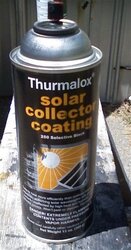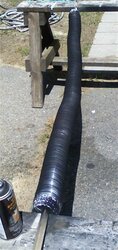hoverfly
Minister of Fire
Black paint absorbs heat well, it does not release very well this stuff works the best.
Thermalox Solar Collector Coating is a Silicone based heat-resistant selective paint designed for use on metal surfaces of solar collector panels - will withstand up to 1000° F. Thurmalox will function with maximum efficiency (absorptivity .96, emissivity .52) when applied 0.5 mils thick. Coverage 25 sq. ft. the coating resists out-gassing (a major cause of internal fogging of collector covers) up to 400° F. Made with heat stable pigments, the coating will withstand repeated thermal cyclings and temperatures as high as 1000° F. Thermalox is unaffected by humidity, and will not peel or discolor. 13 oz. aerosol can. primer not necessary for copper or aluminum.
Thermalox Solar Collector Coating is a Silicone based heat-resistant selective paint designed for use on metal surfaces of solar collector panels - will withstand up to 1000° F. Thurmalox will function with maximum efficiency (absorptivity .96, emissivity .52) when applied 0.5 mils thick. Coverage 25 sq. ft. the coating resists out-gassing (a major cause of internal fogging of collector covers) up to 400° F. Made with heat stable pigments, the coating will withstand repeated thermal cyclings and temperatures as high as 1000° F. Thermalox is unaffected by humidity, and will not peel or discolor. 13 oz. aerosol can. primer not necessary for copper or aluminum.




